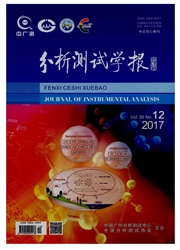

 中文摘要:
中文摘要:
利用碱性磷酸酶(ALP)染色和钙结节(Vonkossa)染色的方法对诱导21 d的淫羊霍苷诱导人脐带间充质干细胞进行鉴定;应用原子力显微镜(AFM)观察淫羊霍苷的形貌和人脐带间充质干细胞诱导0、5、10、15、21 d后的细胞形貌。结果表明,经成骨诱导分化21 d后,ALP染色呈强阳性,Vonkossa染色可见明显钙结节。AFM分析表明,淫羊霍苷在盖玻片上呈分散状分布,在细胞表面上聚集并呈微米域分布。实验发现,由于吸附在细胞表面时,被细胞膜分子包裹,更有利于在细胞表面的吸附,进入细胞内部,细胞表面的淫羊霍苷颗粒较在盖玻片上时增大,由淫羊霍苷颗粒进入细胞后在细胞表面留下一些小孔,可知其通过进入细胞内部诱导成骨分化。分化后,细胞表面有小突触,是由成骨分化后细胞内形成钙结节造成。
 英文摘要:
英文摘要:
Atomic force microscope was used to study the induction of human umbilical cord mesenchymal(hUCM) stem cells into osteogenic differentiation by icariin in vitro at different inducing periods(0,5,10,15,21 days).After 21 days of induction,the induced osteogenic differentiation of hUCM stem cells were evaluated by alkaline phosphatase(ALP)staining and calcium nodules(Vonkossa)staining methods.Results showed that the alkaline phosphate staining for hUCM stem cells after 21 days of osteogenic differentiation was strongly positive and calcium nodules could be evidently observed on the Vonkossa staning.AFM results showed that the icariin particles were dispersively distributed on the coverslip,but aggregated on the cell surface in micron-domain.It was found that the icariin particles on the cell surface were larger than those on the coverslip,since the adsorbed particles on the cell surface were enwrapped by the cell membrane molecules.Some holes were left on the cell surface as the icariin particles entered into the interior of cells,thus the induced osteogenic differentiation of hUCM stem cells were obtained.After differentiation,some small synapses,formed by calcium nodules,were observed on the cell surface.
 同期刊论文项目
同期刊论文项目
 同项目期刊论文
同项目期刊论文
 Photoinactivation effects of hematoporphyrin monomethyl ether on Gram-positive and -negative bacteri
Photoinactivation effects of hematoporphyrin monomethyl ether on Gram-positive and -negative bacteri Atomic Force Microscope-Related Study Membrane-Associated Cytotoxicity in Human Pterygium Fibroblast
Atomic Force Microscope-Related Study Membrane-Associated Cytotoxicity in Human Pterygium Fibroblast Sonodynamic Effects of Hematoporphyrin Monomethyl Ether on CNE-2 Cells Detected by Atomic Force Micr
Sonodynamic Effects of Hematoporphyrin Monomethyl Ether on CNE-2 Cells Detected by Atomic Force Micr Detection of erythrocytes in patient with elliptocytosis complicating ITP using atomic force microsc
Detection of erythrocytes in patient with elliptocytosis complicating ITP using atomic force microsc Curcumin induced nanoscale CD44 molecular redistribution and antigen-antibody interaction on HepG2 c
Curcumin induced nanoscale CD44 molecular redistribution and antigen-antibody interaction on HepG2 c An easy method to detect the kinetics of CD44 antibody and its receptors on B16 cells using atomic f
An easy method to detect the kinetics of CD44 antibody and its receptors on B16 cells using atomic f AFM- and NSOM-based force spectroscopy and distribution analysis of CD69 molecules on human CD4(+) T
AFM- and NSOM-based force spectroscopy and distribution analysis of CD69 molecules on human CD4(+) T Cold Induces Micro- and Nano-Scale Reorganization of Lipid Raft Markers at Mounds of T-Cell Membrane
Cold Induces Micro- and Nano-Scale Reorganization of Lipid Raft Markers at Mounds of T-Cell Membrane Nanostructure and nanomechanics analysis of lymphocyte using AFM: From resting, activated to apoptos
Nanostructure and nanomechanics analysis of lymphocyte using AFM: From resting, activated to apoptos NSOM- and AFM-based nanotechnology elucidates nano-structural and atomic-force features of a Y-pesti
NSOM- and AFM-based nanotechnology elucidates nano-structural and atomic-force features of a Y-pesti Label-free oligonucleotide detection method based on a new L-cysteine-dihydroartemisinin complex ele
Label-free oligonucleotide detection method based on a new L-cysteine-dihydroartemisinin complex ele Connection between biomechanics and cytoskeleton structure of lymphocyte and Jurkat cells: An AFM st
Connection between biomechanics and cytoskeleton structure of lymphocyte and Jurkat cells: An AFM st Electrochemical activity of holotransferrin and its electrocatalysis-mediated process of artemisinin
Electrochemical activity of holotransferrin and its electrocatalysis-mediated process of artemisinin 期刊信息
期刊信息
